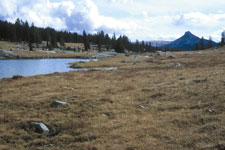What's at Stake
The ThreatsThe Beartooth Plateau Roadless Area is primarily threatened by oil and gas development, particularly in the eastern portion of the area. In addition, although the Shoshone National Forest is critical habitat for recovery of the threatened grizzly and introduced gray wolf, the agency has allowed logging and roadbuilding at an accelerated pace without adequate analysis of the cumulative impacts of these actions. Since 1986, over 5,000 acres of forest in the Clarks Fork Ranger District have been logged with dire consequences for the grizzly: reduced cover, reduced food sources in those areas where whitebark pine trees were lost and increased interaction with humans where new roads have been built to service logging activities. More than 80,000 acres in prime grizzly habitat is available for oil and gas leasing on the Shoshone National Forest. This unacceptable level of industrial development ignores the values of protecting this magnificent ecosystem from further fragmentation. The SolutionsUltimately this area should be protected as wilderness. This is the only way to permanently protect the area. As an interim step, remaining roadless areas such as Deep Lake/Clarks Fork should be recommended as wilderness by the Forest Service. In the meantime, no timber sales or oil and gas leasing and development should be allowed in this roadless area, which is far more valuable for wildlife and recreation. Temporary or illegally developed roads used for logging or by off-road vehicles should be closed and revegetated. Photos by Kirk Koepsel
| |||||||

 Established in 1891, the Shoshone National Forest is named for
the Shoshone tribe of Lewis and Clark's Indian guide, Sacagawea. The
Shoshone National Forest is part of the Greater Yellowstone ecosystem of
northwestern Wyoming, which encompasses 14 million acres, making it the
largest essentially intact temperate ecosystem in the world. Yellowstone
National Park comprises only 16 percent of the ecosystem and areas such as
the unprotected Deep Lake/Clarks Fork Roadless Area are an important
component of a completely functional ecosystem - that, when left alone,
will flourish indefinitely. This eastern portion of the Greater
Yellowstone is critical to the recovery of the grizzly bear and the
perpetual survival of the wolf and the water vole, a species particularly
sensitive to disturbance.
Established in 1891, the Shoshone National Forest is named for
the Shoshone tribe of Lewis and Clark's Indian guide, Sacagawea. The
Shoshone National Forest is part of the Greater Yellowstone ecosystem of
northwestern Wyoming, which encompasses 14 million acres, making it the
largest essentially intact temperate ecosystem in the world. Yellowstone
National Park comprises only 16 percent of the ecosystem and areas such as
the unprotected Deep Lake/Clarks Fork Roadless Area are an important
component of a completely functional ecosystem - that, when left alone,
will flourish indefinitely. This eastern portion of the Greater
Yellowstone is critical to the recovery of the grizzly bear and the
perpetual survival of the wolf and the water vole, a species particularly
sensitive to disturbance.